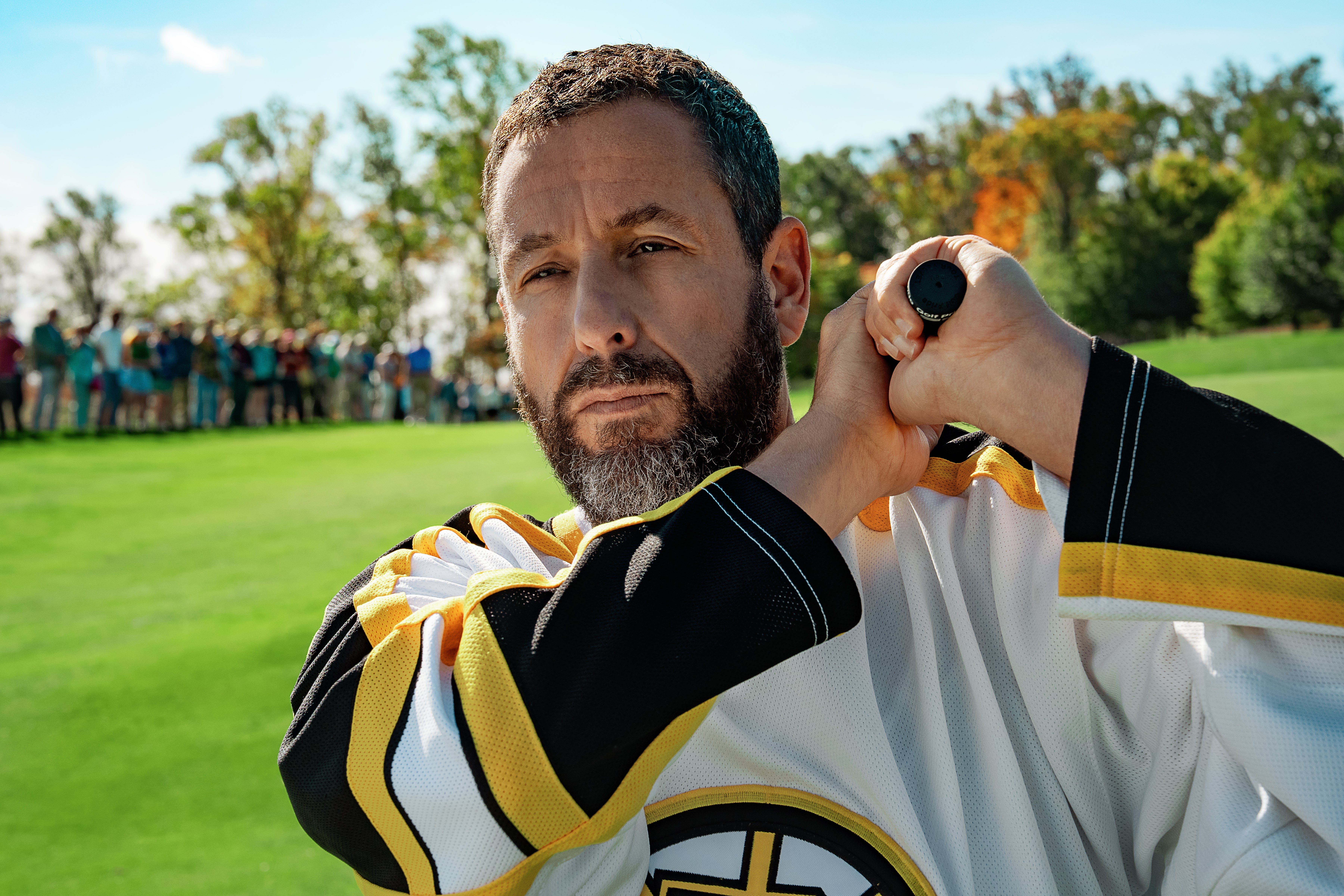It often seems like there are two Adam Sandlers walking the earth. Sandler One is the populist clown, titan of film comedies such as Happy Gilmore, Click and Grown Ups – the man who, over the past 30-odd years, has built himself an empire of the lowbrow. Then there is the seldom-seen Sandler Two – a performer of craft, depth and credibility, who emerges every so often to star in critically acclaimed auteur projects such as Uncut Gems, Punch-Drunk Love and The Meyerowitz Stories. Always these two Sandlers wrestle for dominion – and never the twain shall meet. This, at least, is how the strange phenomenon of Adam Sandler is often framed.
At a glance, Happy Gilmore 2, released on Netflix last Friday, fits snugly into the Sandler One bracket, what Roger Ebert once dismissed as “those moronic comedies”. The film is a sequel to 1996’s Happy Gilmore, in which the Sandman plays a golfing savant with rage issues; the sequel was produced as part of a multi-film deal with Netflix. (It’s a deal that has kept Sandler largely out of cinemas and on the streaming site for the past decade, a partnership estimated to have earned the actor half a billion dollars.) Like many of his films, Happy Gilmore 2 is a broad, spoofy comedy, riddled with celebrity cameos and slapstick gags. Reviews have been middling in a way that’s typical of Sandler’s Netflix era: The Guardian described it as “strictly for the fans”, while The Hollywood Reporter called it “an exercise in fan service”. It is a film in which a character played by Eminem gets torn apart by alligators (for laughs). Need I say more?
But here’s the thing: unless we’re talking about Jack and Jill (2012), there are not, in actuality, two Adam Sandlers. And while it’s enticingly tidy to assess Sandler’s work in two segregated camps – high and low, good and bad – it’s not really representative of his work. In its own way, Happy Gilmore 2 is as apt a portrait of Sandler the artist as there’s been, a film that sums up his craft, his strengths, and his limitations.
Sandler’s comedies are often spoken of as undiluted puerility – and there’s plenty of that on show here. Some of it works, some of it doesn’t. But, through nearly all his films, there also runs a sharp sentimental streak. Happy Gilmore 2 begins – fittingly – with a big swing. Happy’s wife Virginia, the romantic linchpin of the original Gilmore played by Modern Family’s Julie Bowen, is killed by an errant golfball, leaving Sandler’s character a heavy-drinking widower. The death is handled somewhat glibly, but not entirely – the tragedy gives the film a sober undercurrent that, to some extent, grounds Sandler’s performance. In any event, this is a very different Happy Gilmore from the stroppy manchild we met back in 1996: the mellower, family-man vibe aligns the character with some of Sandler’s more three-dimensional roles, such as the put-upon basketball scout in 2022’s Hustle.
The original Happy Gilmore focused on what might be Sandler’s most discussed onscreen quality: anger. His is an explosive temper, blown up to ludicrous comic extremes. (He even starred in a film called Anger Management.) In most of his work, however, this anger is tempered by a softness, an innate, sappy affability that offsets the brasher edges of his persona. This applies just as much to a film such as Uncut Gems – in which Sandler is by turns pathetic, enraging, and chaotic as spiralling gambling addict Howard Ratner – as it does to Happy Gilmore.
Another running theme throughout Sandler’s career has been his stable of repeat collaborators, and never has this been more front and centre than with Happy Gilmore 2. Plum roles are given to his immediate family – his teenage daughters, Sunny and Sadie Sandler, both feature prominently here, while his wife Jackie makes an appearance – but also to his wider social circle. It’s a Rolodex that ranges from formidable talents, such as Steve Buscemi, or actor-director Benny Safdie (here cast as the obnoxious villain), to abject hangers-on, such as longtime Sandler repertory player Rob Schneider (here relegated to a mercifully brief cameo).

Sandler has been (fairly) criticised in some circles for what amounts to unapologetic nepotism. But it’s also, at this point, intrinsic to his whole deal – this image of the actor as a loyal and beneficent friend to all. It’s a persona that’s somehow endured down the decades, withstood Sandler’s meteoric ascension from regular movie stardom to the sort of towering uber-wealth that ought to have alienated him. There is no role Sandler has played that does not, in some way, draw upon this ingrained likeability.
Later this year, Sandler will star in Jay Kelly, the new film by Noah Baumbach, the Oscar-nominated filmmaker who drew a sublime and subtle performance out of him in 2019’s The Meyerowitz Stories. If Baumbach’s previous work is anything to go by, it’s likely to be a classy, well-acted affair; expect it to be placed carefully onto the “good Sandler” pile. Happy Gilmore 2 will inevitably be chucked haphazardly onto the other one. But there’s value in what he’s doing here – heart, sincerity and comic invention. It may be “for the fans” – but Adam Sandler has a lot of fans for a reason.
‘Happy Gilmore 2’ is available to stream now on Netflix


